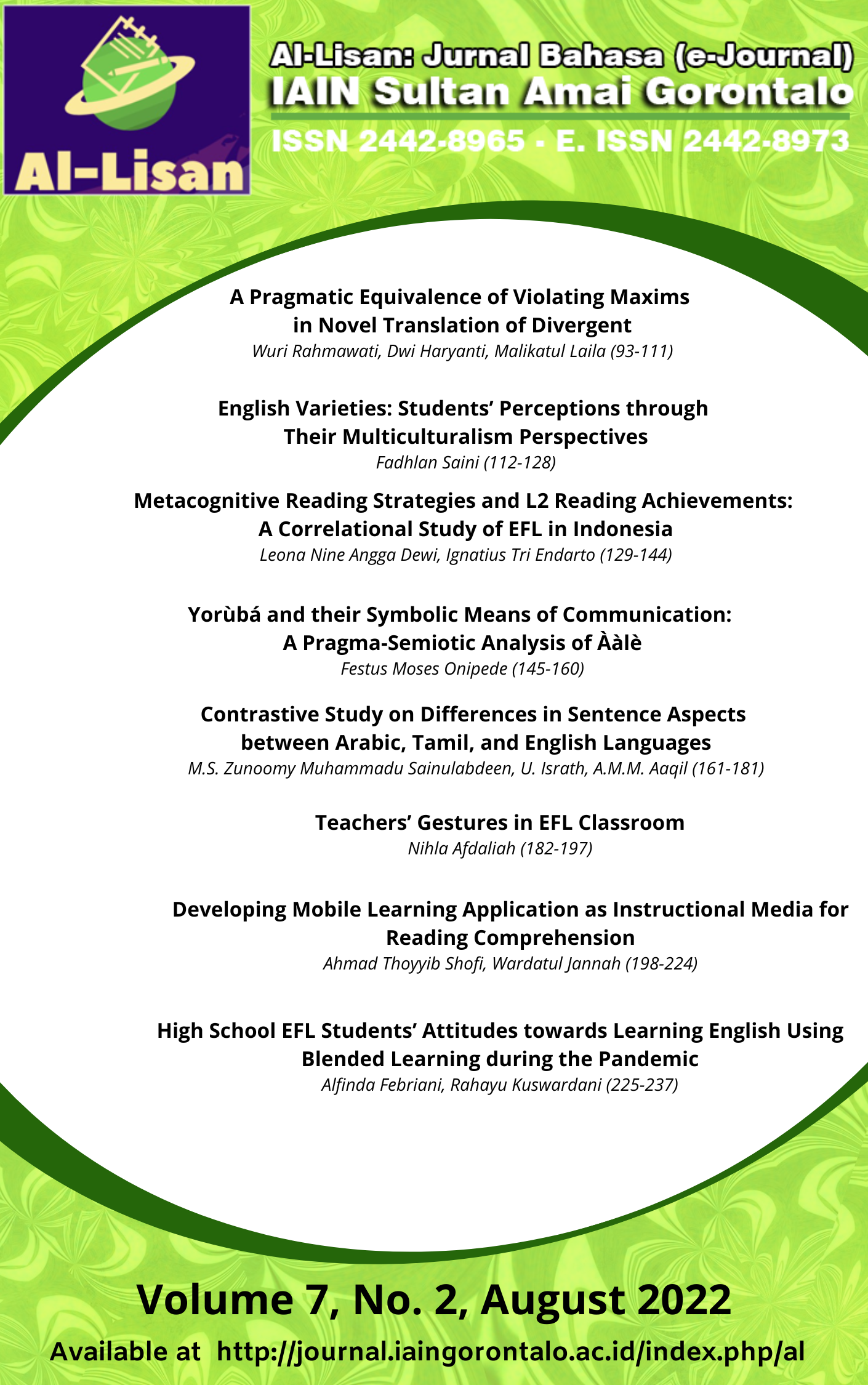High School EFL Students’ Attitudes towards Learning English Using Blended Learning during the Pandemic
DOI:
https://doi.org/10.30603/al.v7i2.2738Keywords:
Blended learning;, English as a Foreign Language;, EFL students;, attitudesAbstract
After the COVID-19 cases were reduced, blended learning was used as a learning method in Indonesia. This study aimed to determine high school EFL students' attitudes about using blended learning to aid them in learning English during the pandemic. This research used a quantitative research design with a survey questionnaire as a data collection method and a Likert scale as the data measurement. The participants were collected by convenience sampling method. They are consisted of 32 senior high school students from SMAN 16 Surabaya, SMAN 20 Surabaya and SMA Muhammadiyah 2 Surabaya. This study used descriptive analysis to analyze the findings. The result showed that high school EFL students in Surabaya presented a neutral attitude toward blended learning. In addition, the students showed the best results for the teacher's learning media and the lowest effects for virtual learning. Based on these findings, high school English teachers should improve their online learning practice since the results showed students’ disinterest in it.
Downloads
References
AlRouji, O. (2020). The Effectiveness of blended learning in enhancing saudi students’ competence in paragraph writing. English Language Teaching, 13(9), 72. https://doi.org/10.5539/elt.v13n9p72
Beaver, J.K. Hallar, Brittan H, W. L. (2014). Blended-learning-PERC-research-brief-September-2014.pdf (Issue September).
Dahmash, N. Bin. (2020). ‘I couldn’t join the session’: benefits and challenges of blended learning amid covid-19 from EFL students. International Journal of English Linguistics, 10(5), 221. https://doi.org/10.5539/ijel.v10n5p221
Fishman, J., Yang, C., & Mandell, D. (2021). Attitude theory and measurement in implementation science: a secondary review of empirical studies and opportunities for advancement. Implementation Science, 16(1), 1–10. https://doi.org/10.1186/s13012-021-01153-9
Garrett, P. (2010). Attitudes to language: Key topics in sociolinguistics.
Grubor, J. (2021). What Makes up the Attitude to Learning English : EFLS-ALE Scale What Makes up the Attitude to Learning English : EFLS-ALE Scale. December, 30–51.
Hrastinski, S. (2019). What do we mean by blended learning? TechTrends, 63(5), 564–569. https://doi.org/10.1007/s11528-019-00375-5
Kenneth S. Bordens Irwin A. Horowitz. (2008). Social psychology. In Psychosocial Foundation of Nursing. https://doi.org/10.5005/jp/books/11375_49
Khidzir, K. A. M., Ismail, N. Z., & Abdullah, A. R. (2018). Validity and reliability of instrument to measure social media skills among small and medium entrepreneurs at PengkalanDatu River. International Journal of Development and Sustainability, 7(3), 1026–1037. www.isdsnet.com/ijds
Munir, MaemunaMuhayyang, SunarliaLimbong, A. A. (2021). Students’ Attitudes on Blended Learning-Based Instruction in Indonesian EFL Classroom. GNOSI: An Interdisciplinary Journal of Human Theory and Praxis, 4(2), 146–162.
Pallant, J. (2016). SPSS Survival Manual, 6th edition, 2016. Open University Press.
Pinto-Llorente, A. M., Sánchez-Gómez, M. C., García-Peñalvo, F. J., & Casillas-Martín, S. (2017). Students’ perceptions and attitudes towards asynchronous technological tools in blended-learning training to improve grammatical competence in English as a second language. Computers in Human Behavior, 72, 632–643. https://doi.org/10.1016/j.chb.2016.05.071
Rahim, M. N. (2019). The use of blended learning approach in EFL education. International Journal of Engineering and Advanced Technology, 8(5), 1165–1168. https://doi.org/10.35940/ijeat.E1163.0585C19
Simbolon, N. E. (2021). EFL students’ perceptions of blended learning in English language course: learning experience and engagement. Journal on English as a Foreign Language, 11(1), 152–174. https://doi.org/10.23971/jefl.v11i1.2518
Sugiyono, D. (2013). MetodePenelitianKuantitatif, Kualitatif, dan Tindakan.
Wang, N., Chen, J., Tai, M., & Zhang, J. (2021). Blended learning for Chinese university EFL learners: learning environment and learner perceptions. Computer Assisted Language Learning, 34(3), 297–323. https://doi.org/10.1080/09588221.2019.1607881
Wright, B. M. (2017). Blended learnings student perception of face-to-face and online EFL lessons. Indonesian Journal of Applied Linguistics, 7(1), 64–71. https://doi.org/10.17509/ijal.v7i1.6859
Downloads
Published
How to Cite
Issue
Section
License
Copyright (c) 2022 Alfinda Febriani, Rahayu Kuswardani

This work is licensed under a Creative Commons Attribution-ShareAlike 4.0 International License.
Copyright Notice
Authors who publish in Al-Lisan: Jurnal Bahasa (e-Journal) agree to the following terms:
- Authors retain copyright and grant the journal right of first publication with the work simultaneously licensed under a Attribution-ShareAlike 4.0 International (CC BY-SA 4.0) License that allows others to share the work with an acknowledgment of the work's authorship and initial publication in this journal.
- Authors are able to enter into separate, additional contractual arrangements for the non-exclusive distribution of the journal's published version of the work (e.g., post it to an institutional repository or publish it in a book), with an acknowledgment of its initial publication in this journal.
- Authors are permitted and encouraged to post their work online (e.g., in institutional repositories or on their website) prior to and during the submission process, as it can lead to productive exchanges, as well as earlier and greater citation of published work.












